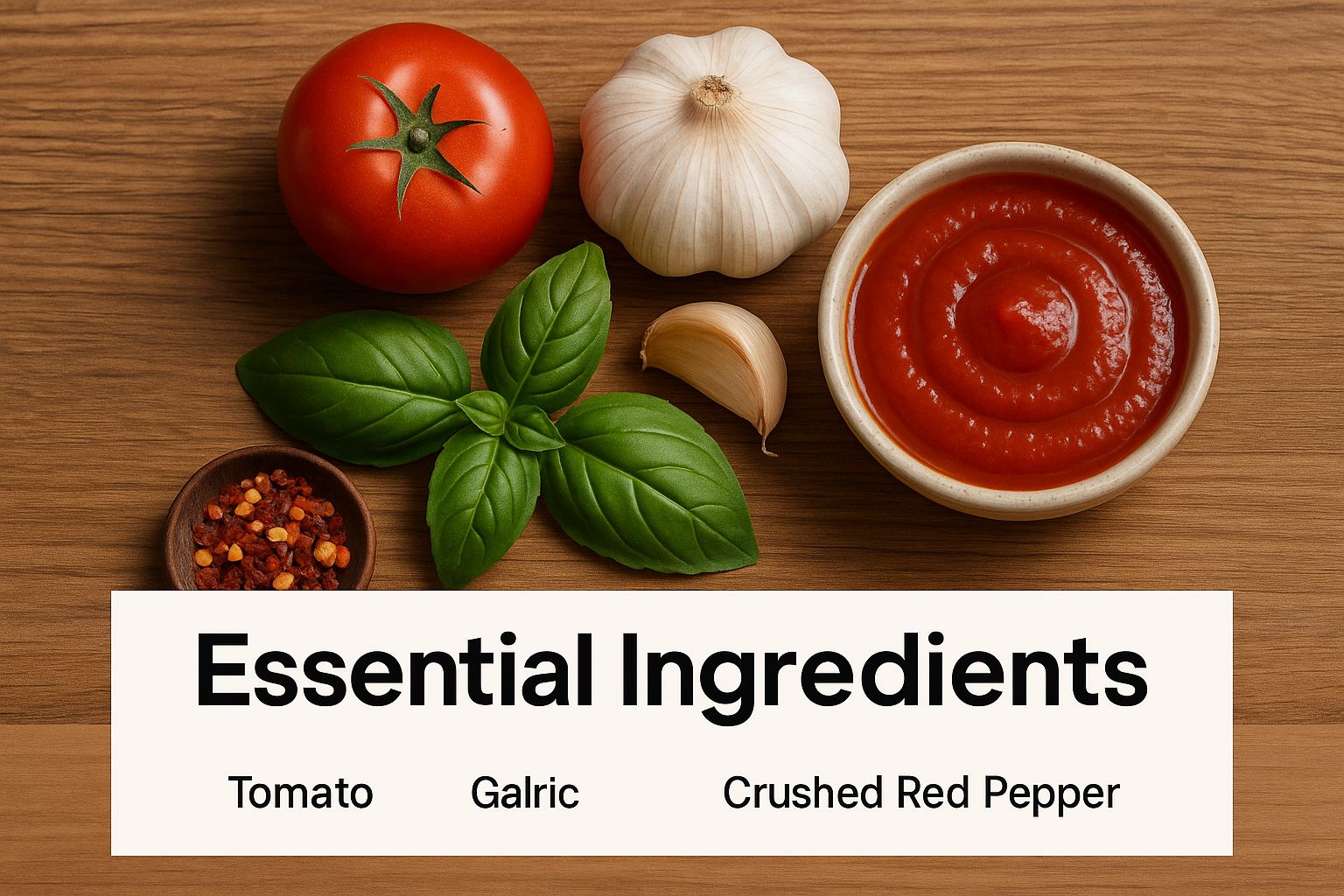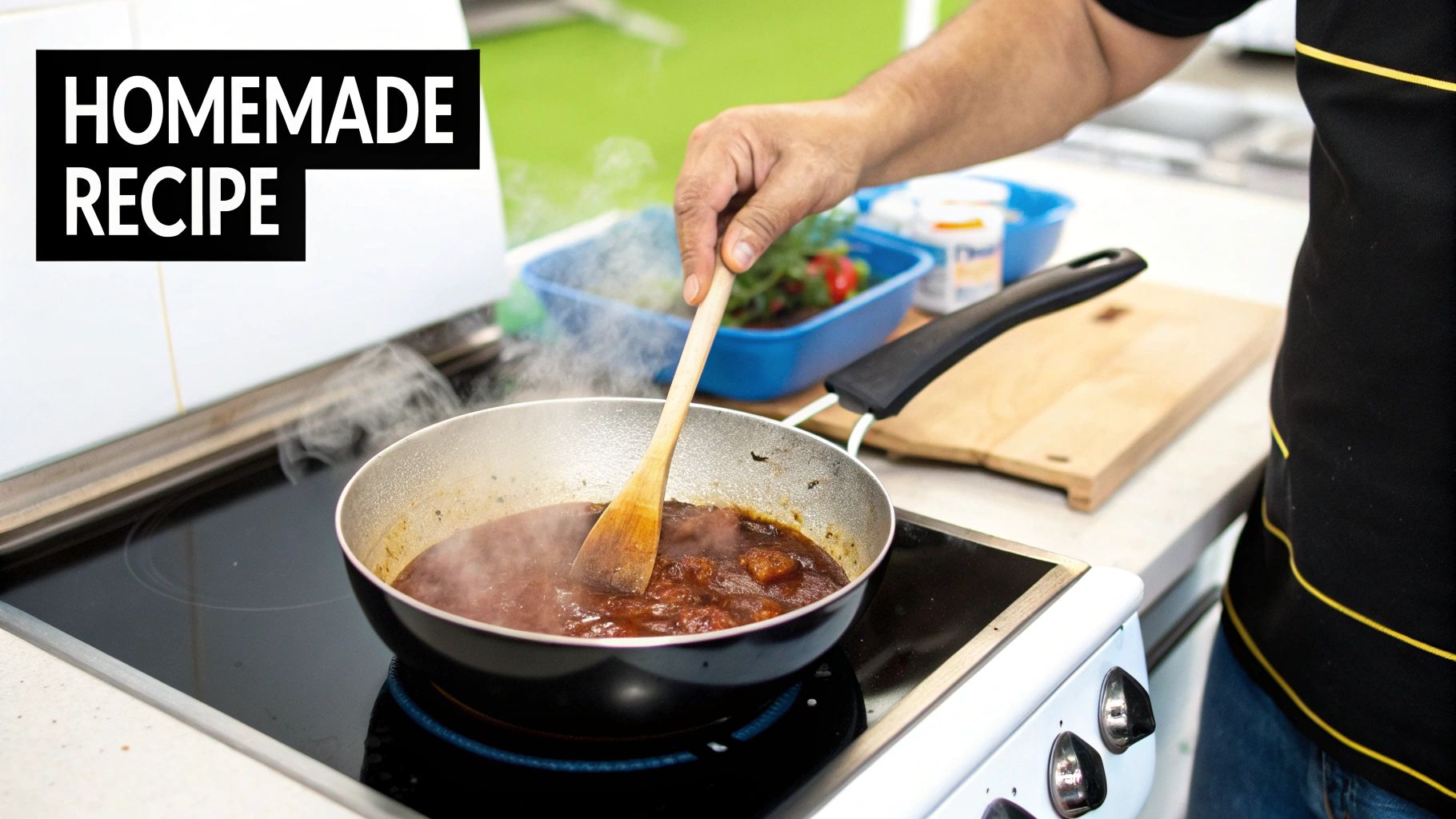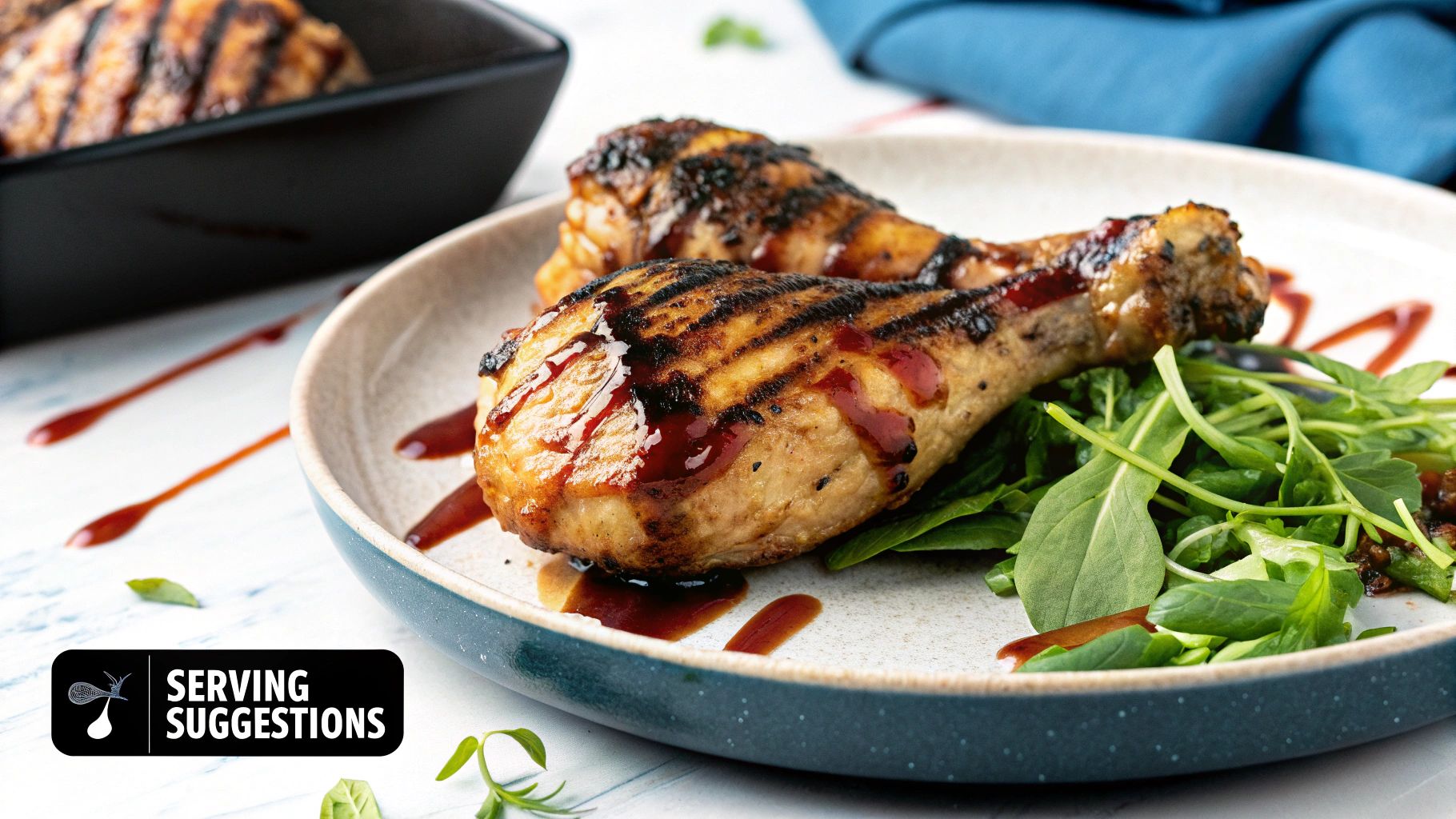Your Ultimate Guide to Gluten Free Barbeque Sauce
Finding a killer gluten-free barbeque sauce isn’t just about dodging an ingredient. It's a mission for pure, authentic flavour. So many big-brand sauces are packed with gluten-hiding junk and fillers that dull the taste—a real problem for anyone who needs to avoid it. This guide is your way into a world of incredible flavour, with none of the crap.
Flavour and Safety: Why They’re the Same Thing
Choosing a gluten-free barbeque sauce is a smart move for everyone, not just those who need it. Whether you're a serious BBQ enthusiast, a flavour pioneer, or just cooking for the family, it's about cleaner eating and, frankly, better flavour.
For someone with coeliac disease or a gluten sensitivity, it’s non-negotiable. But even if you can eat anything, going gluten-free with your sauce usually means you're getting a higher quality product made with real, honest ingredients. This isn't just a niche thing anymore; people care more about what's in their food. At Smokey Rebel, we believe you shouldn't have to compromise on taste for quality.
So, What Actually Makes a BBQ Sauce Gluten-Free?
It all comes down to what’s in the bottle. A proper gluten-free barbeque sauce steers clear of the usual suspects that contain wheat, barley, or rye.
- No Malt Vinegar: A lot of old-school sauces get their tang from malt vinegar, which is made from barley. A good gluten-free version will use apple cider vinegar or distilled white vinegar instead for that sharp, clean kick.
- Gluten-Free Soy Sauce (or Tamari): Regular soy sauce is brewed with wheat. The best alternative is tamari, which brings all that rich, savoury umami goodness without any of the gluten.
- No Dodgy Thickeners: Ever seen ‘modified food starch’ on a label? That can be code for wheat. The best gluten-free sauces don't need it—they use real tomato paste or just let the sauce simmer down naturally to get that perfect, thick consistency.
It’s simple: focus on real ingredients and honest labels, and you get pure flavour in every drop. That's the Smokey Rebel way. No fillers, just incredible taste packed in our craft cans.
How to Read Labels and Spot Hidden Gluten
Trying to find a genuinely gluten-free barbecue sauce in the supermarket can feel like a proper mission. Gluten is a sneaky one, often hiding behind innocent-sounding names on the ingredients list. Your best weapon? Learning how to read a label like a pro.
It’s not just about looking for the word "wheat." A lot of additives and flavourings come from gluten-containing grains, and you need to know the code words they use.
The Usual Suspects: Common Gluten Culprits
First things first, you need to know what you’re looking for. Certain ingredients are almost always a red flag for gluten. Think of things like maltodextrin (which can be derived from wheat), yeast extract, and even some starches used to thicken sauces.
- "Natural Flavourings": This is a big one. The term is so broad it can legally hide ingredients derived from barley and rye. If a product isn't certified gluten-free, this is a risky bet.
- "Malt": If you see "malt" anywhere in the name—like malt vinegar or malt syrup—it comes from barley. Steer clear.
- "Hydrolysed Vegetable Protein (HVP)": This is often made from wheat unless the label specifically says otherwise.
To make this easier, here’s a quick-glance table to help you spot the good from the bad when you're scanning labels in the aisle.
Gluten-Containing Ingredients vs Safe Gluten-Free Alternatives
| Common Gluten-Containing Ingredient | Potential Source in BBQ Sauce | Safe Gluten-Free Alternative |
|---|---|---|
| Malt Vinegar | Acidity, sharp flavour base | Apple Cider Vinegar, Distilled White Vinegar |
| Wheat Flour | Thickening agent | Cornflour, Arrowroot Powder, Xanthan Gum |
| Soy Sauce (traditional) | Umami, saltiness, colour | Tamari (gluten-free soy sauce), Coconut Aminos |
| Beer | Flavour base in some craft sauces | Gluten-Free Beer, Cider, or stock |
| "Natural Flavourings" | Can contain barley or rye extracts | Sauces with certified gluten-free labels or specific flavourings listed |
| Modified Food Starch | Thickener (can be wheat-based) | Starch specified as corn, potato, or tapioca-based |
This isn't an exhaustive list, but it covers the main offenders you’re likely to run into. Stick to simple, recognisable ingredients, and you’ll be on the right track.

When a sauce is built from clean, simple ingredients like these, you get that authentic barbecue flavour without any of the junk.
Making the Right Choice With Confidence
Thankfully, the UK's mandatory allergen labelling makes spotting gluten easier, but you're still relying on producers to be diligent. That’s why understanding what certifications mean is key for anyone who cares about what they eat.
The real goal is finding a sauce you can trust without having to turn into a food detective every time you shop. That's our whole philosophy at Smokey Rebel—we sort out the details so you can just focus on the flavour.
When a brand is transparent and commits to a "no added crap" policy, you know you're in safe hands.
If you’re after a straightforward, seriously delicious option, have a look at our range of craft gluten-free BBQ sauces. Every bottle is a promise of pure, authentic flavour, ready for everything from chicken wings to a massive slab of ribs.
Our Ultimate Homemade Gluten-Free BBQ Sauce Recipe
Right, let’s get our hands dirty and make a barbeque sauce that’ll make you forget shop-bought stuff ever existed. This is all about real ingredients and real flavour, following our ‘no added crap’ philosophy to a tee.
We’re not just giving you a list of instructions. We’ll show you the ‘why’ behind the method, proving that authentic cultural flavour comes from getting the basics right, not from a bottle full of fillers. You’re in complete control here.
Building Your Flavour Base
Every great homemade gluten-free barbeque sauce starts with a solid foundation. We’re kicking things off with quality ingredients you can grab from any supermarket. The secret is layering these flavours properly from the start.
Here’s what you’ll need to pull it all together:
- Tomato Passata: One 500g carton. This gives you a smooth, clean tomato base without any seeds or skin.
- Apple Cider Vinegar: About 120ml. This is non-negotiable for that sharp, tangy kick that cuts through the sweetness.
- Dark Brown Sugar: Roughly 100g for that deep, molasses-rich sweetness.
- Gluten-Free Tamari: You’ll need 3 tablespoons. It delivers a proper umami hit that regular soy sauce (which contains wheat) just can't match.
- Smoked Paprika: A full two tablespoons. Don't be shy with this one – it's where that authentic smoky flavour comes from.
- Garlic & Onion Powder: One tablespoon of each. These two build the aromatic backbone of the sauce.
- Dijon Mustard: Just a single tablespoon adds a sharp, complex note that lifts everything.
This combo nails that perfect balance of sweet, smoky, and tangy. It’s a knockout on everything from slow-cooked pulled pork to a tray of roasted veg.
The Art of the Simmer
Got all your ingredients? Tip everything into a medium-sized saucepan. Before you even think about turning on the heat, give it all a good whisk until the sugar has dissolved and you can’t see any clumps of spice.
Now, bring it all to a gentle simmer over a medium heat, then knock it straight back to low. This is where the real work gets done. Let it bubble away gently for at least 30-40 minutes, giving it a stir every now and then to stop it from catching. Don't rush this part.
A slow, patient simmer does two crucial things. First, it lets all those individual flavours get to know each other and deepen into something genuinely complex. Second, it thickens the sauce naturally to that perfect, clingy consistency without needing any gluten-y starches.
You’ll know it’s ready when the colour has darkened and it’s thick enough to coat the back of a spoon. If you like your sauce super smooth, you can blitz it with an immersion blender, but honestly, it’s fantastic as is.
And if you’re on a roll with sauce-making, check out our simple but fiery chilli sauce for kebabs recipe.
Once it's done, let the BBQ sauce cool down completely before you pour it into an airtight jar. It’ll keep happily in the fridge for up to two weeks – and the flavour only gets better after a day or two. This is your new secret weapon.
Creative Ways to Use Your BBQ Sauce
Right, you’ve nailed the homemade gluten-free barbeque sauce. Now for the fun part. Forget just slapping it on ribs at the last second—this sauce is a secret weapon that can transform everyday meals with zero fuss.
We’re talking about turning simple ingredients into something genuinely impressive, with practical, step-by-step methods.

Think of it as more than a topping; it's a core ingredient. Try it as a rich, smoky base for a pizza instead of the usual tomato sauce. Or use it to make incredible BBQ beans. The possibilities are huge, and the techniques are simple enough for any night of the week.
5-Minute BBQ Chicken Thighs for the Air Fryer
This is the ultimate weeknight cheat meal. Here's how to get juicy, flavour-packed chicken thighs in minutes.
- Prep: Pat 4 boneless, skinless chicken thighs completely dry with a paper towel. This is crucial for getting a good sear.
- Season: Place the chicken in a bowl. Drizzle with a little olive oil, then add 1 tbsp of a good all-purpose BBQ rub (think paprika, garlic powder, salt, and pepper). Toss to coat everything evenly.
- Cook: Arrange the thighs in a single layer in your air fryer basket. Cook at 200°C for 15-18 minutes, flipping halfway through.
- Glaze: For the last 2 minutes of cooking, brush a generous layer of your gluten-free barbeque sauce over the thighs. This gives you a perfect caramelised glaze without burning the sauce.
- Serve: Let them rest for a minute before serving. Done.
How to Make Unforgettable BBQ Pulled Pork
This is where your sauce really comes into its own, creating fall-apart tender, flavour-packed pulled pork in a slow cooker with almost no effort. This is a perfect example of pairing seasonings for BBQ pulled pork with a great sauce.
- Rub: Take a boneless pork shoulder (around 1.5kg) and pat it dry. In a small bowl, mix your favourite pork rub—a blend of smoked paprika, brown sugar, salt, pepper, and a pinch of cayenne is perfect. Rub this mixture all over the pork.
- Sear (Optional but Recommended): Heat a little oil in a pan and sear the pork shoulder on all sides until golden brown. This builds a deeper flavour.
- Slow Cook: Place a sliced onion in the bottom of your slow cooker and sit the pork on top. Pour over about half of your homemade barbeque sauce. Put the lid on and cook on low for 8-10 hours.
- Shred & Sauce: Once cooked, the pork will be incredibly tender. Use two forks to shred it directly in the slow cooker, mixing it into all those juices. Stir in the rest of your BBQ sauce, and you’re good to go.
Pairing Flavours with Your Gluten-Free Sauce
A truly great BBQ is never just about the sauce. It’s about the incredible dance between the wet and the dry—that rich, tangy gluten-free barbeque sauce working in perfect harmony with a well-chosen dry rub. This is how you build layers of authentic flavour and turn a good meal into something unforgettable.

The key is to think about complementing, not competing. Your homemade sauce already has a beautiful balance of sweet, smoky, and tangy notes. The right rub will enhance those qualities, adding its own depth and texture without completely taking over.
Perfect Pairings for Your Protein
Different meats call for different game plans. A bold, peppery rub that’s fantastic on brisket might steamroll a delicate piece of chicken. Here are a few real-world examples to get you started on your flavour journey.
- Seasonings for BBQ Ribs: This rich, fatty meat needs seasonings that can hold their own. For ribs, you want a classic smoky and sweet profile. Mix smoked paprika, dark brown sugar, black pepper, and just a hint of cayenne. This combo creates that beautiful bark everyone loves and just sings alongside a tangy sauce.
- BBQ Seasonings for Chicken: Chicken is a blank canvas for savoury, aromatic flavours. A great rub for chicken might include garlic powder, onion powder, dried oregano, and a touch of mustard powder. These herbs and spices cut right through the richness of the sauce, adding a fragrant, almost herby layer to each bite.
- BBQ Rubs for Vegetables: Don't forget the veg! For things like corn on the cob, peppers, or courgettes, a simple rub of salt, pepper, garlic powder, and a little smoked paprika works wonders before grilling. A final drizzle of BBQ sauce adds a sweet and smoky finish.
- Brisket or Beef Ribs: Beef demands a bold, simple approach. You can’t go wrong with a classic Texas-style rub, which is often just equal parts coarse black pepper and sea salt. It’s all you need to create a powerful crust that complements the tangy sauce without adding too much complexity. If you want to dive deeper, check out our guide on **what spices go well with beef**.
The goal is to build a symphony of flavour where every element plays its part. The rub provides the deep, foundational flavour and texture, while your gluten-free barbeque sauce brings the moisture, sweetness, and tang that ties it all together.
FAQ: Your Gluten-Free BBQ Questions Answered
Going gluten-free can throw up a few curveballs, especially when you’re trying to nail that authentic barbecue flavour. We get asked a lot of the same questions, so we’ve rounded them up here to give you clear, straight-up answers.
Is most BBQ sauce gluten-free?
No, unfortunately not. Many commercial BBQ sauces use malt vinegar (from barley), wheat-based soy sauce, or wheat starch as thickeners. Always check the label for "gluten-free" certification or a clear ingredients list that avoids wheat, barley, and rye.
How long can I store homemade gluten-free barbecue sauce?
Your homemade sauce, made with no nasty preservatives, will last for up to two weeks in the fridge when stored in an airtight container like a clean jar. The apple cider vinegar acts as a natural preservative. For longer storage, freeze it in freezer-safe bags or ice cube trays for up to three months.
Is Worcestershire sauce always gluten-free?
This is a classic trip-up. No, traditional Worcestershire sauce is almost never gluten-free. The unique umami tang usually comes from malt vinegar, which is made from barley. Thankfully, you can now find plenty of specifically labelled gluten-free versions in most supermarkets. Always, always check the label for a "gluten-free" certification to be certain.
Can I make this homemade BBQ sauce recipe spicier?
Absolutely! This recipe is a brilliant base that’s just begging to be customised. For a clean heat, add a pinch of cayenne pepper. For a smokier spice, try adding a finely diced chipotle pepper in adobo sauce. Or, a teaspoon of your favourite gluten-free hot sauce will do the trick. Start small, taste as you go, and add more until you hit that perfect level of fire.
Ready to skip the guesswork and get straight to incredible flavour? The team at Smokey Rebel has perfected a range of craft BBQ rubs and sauces that are all about authentic taste with no added crap.
Explore our full collection and find your new secret weapon at https://smokeyrebel.com.
Join our Mailing List
Sign up and get Smokey Rebel Recipes + weekly recipes straight to your inbox!
Recent articles
Your Ultimate Guide to Gluten Free Barbeque Sauce
Discover how to find, make, and use the best gluten free barbeque sauce. This guide has everything from reading labels...
Read moreYour Guide to Gluten Free Barbecue Sauce
Discover which ingredients to avoid and find your new favorite gluten free barbecue sauce. Learn to read labels and make...
Read moreEasy Homemade BBQ Sauce Gluten Free Recipe
Discover how to make a rich, smoky bbq sauce gluten free from scratch. This guide offers an easy recipe, key...
Read more


